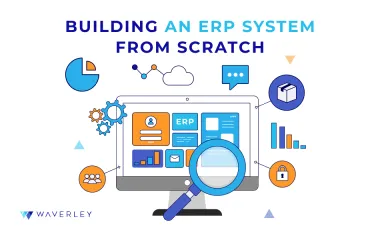OSS and BSS Software Development Guide
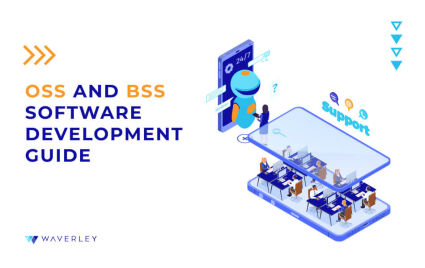
Contents
OSS and BSS solutions integrated into software systems help Telecom companies function effectively and keep track of their operations. These tools are especially valuable for mobile, fixed-line, and Internet operators. These two types of systems address many specific needs of different functional areas within these businesses and support the business activities and customer service processes for Telecom companies.
In this article, we will explain the main principles of OSS and BSS systems, the steps of the software development lifecycle, and how to ensure security during OSS & BSS application development. We will also review some real-life cases of OSS application development.
Understanding OSS and BSS Systems
What do OSS (Operational Support Systems), and BSS (Business Support Systems) stand for? What are their features and characteristics? Where do OSS/BSS intersect or overlap?
It’s very important to state that the combination of OSS and BSS systems allows communication networks to effectively and efficiently provide services to subscribers.
What are Operational Support Systems (OSS) and Business Support Systems (BSS) in Telecom?
The telecommunication industry is a sector made up of companies that provide communication (internet, cell connection, etc.) globally through ordinary or fiber-optic cables, or wireless means. Telecom offers the infrastructure that enables data such as text, voice, and audio/video to be sent worldwide. It’s a crucial feature for modern business operations as network IT solutions are the key to their growth. Reliable network infrastructure is a must for big data applications which are commonly used by companies for business analysis nowadays.
But what about OSS (Operations Support System) and BSS (Business Support System)?
OSS and BSS are the two main functions of the telecom industry. These functions are designed to increase customer service quality, decrease operating costs, and improve network reliability.
What is OSS?
An Operations Support System (OSS) is used by the Communications Service Providers (CSP) to manage their networks. An OSS system supports several functions that are required to manage a telecommunication network such as:
- service provisioning and activation
- network inventory
- fault management
- network configuration.
CSPs typically collaborate with OSS vendors to customize their OSS systems depending on their network structure and service portfolios. According to the TM Forum Business Process Framework for Telecommunications Operators, an OSS system offers Fulfillment, Assurance, and Billing of services.
An OSS system is usually accompanied by a Business Support System (BSS), which acts as the customer-facing software and accepts service-related requests from the customers or the operator. The requests are forwarded to the OSS system for the actions on the network. It must be noted that not all requests to OSS systems involve network configuration.
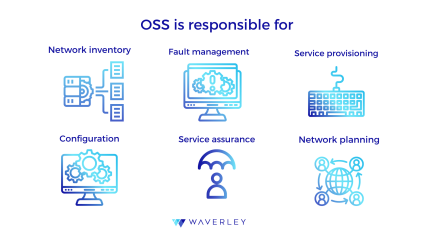
Thanks to OSS mobile operators can remotely manage and monitor day-to-day operations, maintenance issues, and activities across the entire network, all from one central location. The system records and captures all network information and presents the data in an easy-to-read format. Therefore, OSS development and integration is a critical network architecture component.
What is BSS?
BSS is a kind of software developed to help telecom organizations manage and streamline all customer-facing activities. BSS covers the whole telecom business, from ordering services to resolving billing issues to upgrading subscriptions.
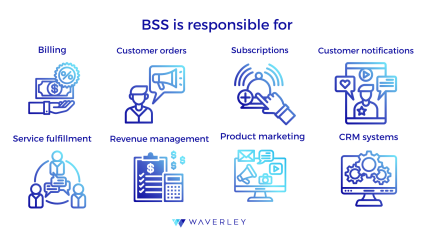
It’s not a secret that customer experience plays a key role in any industry, so effective BSS solutions help telecom companies simplify workflow, monitor service quality, and resolve customer issues in no time.
Key Functions of OSS and BSS
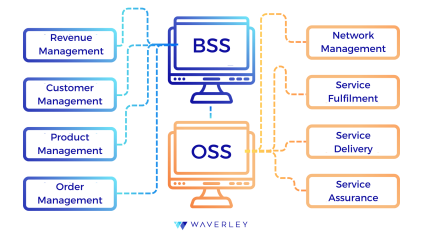
Let’s look deeper into the functions of OSS and BSS. Effective BSS and OSS systems offer many different benefits for the telecommunication industry, especially in revenue generation. These systems often work in a bundle. For example, an OSS can onboard customers to a network and ensure connectivity. The BSS will then ensure that the customer is billed correctly and provide them with information related to personalized offers and promotions that meet their needs. In this way, both systems ensure a great customer experience.
| Function | Description |
|---|---|
| Network Management | OSS supervises and manages the network infrastructure, which involves the configuration and control of telecommunications equipment, as well as monitoring its performance. This ensures that the network functions optimally. |
| Service Delivery | OSS Service Delivery encompasses tasks such as service activation, configuration management, network provisioning, and ensuring the timely and accurate delivery of services according to customer requirements and service level agreements (SLAs). |
| Service Fulfilment | OSS Service Fulfilment involves tasks such as order management, service activation, network provisioning, configuration management, and ensuring that services are delivered accurately and on time according to customer specifications and service level agreements (SLAs). |
| Service Assurance | OSS Service Assurance involves tasks such as fault management, performance monitoring, event correlation, root cause analysis, service level management, and reporting. |
| Resource Control | OSS systems manage network resources, such as bandwidth allocation, capacity management, and IP address management. This is crucial to ensure the availability of resources when users require them. |
| Troubleshooting | Network problems are detected and diagnosed, enabling rapid resolution. This feature is vital to minimize downtime and ensure a seamless experience for users. |
Regarding BSS, these software systems focus on commercial, financial, and customer relationship operations. BSS handles order intake, payment issues, and revenue. It supports OSS in four key business processes.
| Function | Description |
|---|---|
| Revenue Management | Includes various processes and functionalities within BSS that handle the end-to-end lifecycle of revenue generation, from capturing usage data to billing customers and managing revenue streams. BSS Revenue Management involves tasks such as rating and charging, invoicing, payment processing, revenue assurance, fraud management, and revenue reporting. |
| Customer Management | CM involves numerous processes and functionalities within BSS that handle the end-to-end lifecycle of customer interactions, from initial contact to ongoing support and retention. BSS CM tasks are customer account management, order processing, service activation, billing inquiries, complaint handling, and customer support. It aims to provide a seamless and personalized experience for customers, enhance customer satisfaction and loyalty, and maximize customer lifetime value. |
| Product Management | This BSS function handles the creation, configuration, pricing, promotion, and maintenance of products and services throughout their lifecycle. BSS Product Management involves tasks such as product definition, catalog management, pricing strategy, bundling, provisioning rules, and promotional offers. It aims to ensure that telecommunications products and services meet the needs of customers. |
| Order Management | BSS Order Management involves tasks such as order capture, validation, processing, provisioning, and activation. It aims to ensure that customer orders are accurately captured, processed efficiently, and fulfilled according to customer specifications and service level agreements (SLAs). |
While OSS tasks are related to network management, the tasks of BSS cover customer management. There are two different areas of the business, but OSS/BSS software development works in tandem to improve end-to-end telecommunications services. And now let’s take a closer look at the key differences between OSS and BSS.
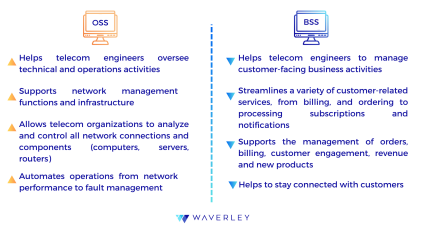
Software Development Lifecycle for OSS and BSS Systems
The Software Development Lifecycle (SDLC) is a structured process for planning, creating, testing, deploying, and maintaining software systems. Setting up the correct SDLC for OSS and BSS systems is a crucial step to ensure success. The OSS software development and the BSS software development lifecycles have similar stages such as analysis, system design, testing, deployment, etc.
If we were to summarize the generic process for operational support systems development and business support systems development lifecycle, it would look approximately like this:
1. Requirements Analysis
This stage includes gathering and analyzing requirements from stakeholders, including network operators, business users, and end customers. In addition, at this stage, we work on defining functional and non-functional requirements for OSS and BSS systems, considering scalability, performance, security, and usability.
2. System Design
Here we are talking about designing the architecture and components of the OSS and BSS systems based on the gathered requirements. This stage also must include defining the data model, user interfaces, workflows, and integration points with other systems that a Telecom company relies on.
3. Development Process and Tools
This is one of the most important processes, and it is also time-consuming. It includes developing and implementing software components of the OSS and BSS systems according to the design specifications and sing programming languages, frameworks, and development tools suited for building robust and scalable systems.
4. Testing and QA
After the development stage, we need to ensure bug-free performance for end users, and here’s where testing & QA practices come into play. Commonly used practices are various types of testing such as regression testing, integration testing, system testing, and acceptance testing to identify and address any defects or issues discovered during testing.
5. Deployment and Integration
This phase includes deploying the OSS and BSS systems in the production environment. For example, we need to configure the systems according to the production environment requirements, including hardware, software, and network configurations. Also, the team conducts deployment testing to verify that the systems are functioning correctly in the production environment.
6. Monitoring and Maintenance
During this stage, the developers focus on providing support for users, troubleshooting issues, and implementing updates or enhancements as needed. Performing regular maintenance activities, such as patching, upgrading, and optimizing the systems to meet changing requirements and industry standards can also be done at this stage.
7. Continuous Improvement
Collecting and analyzing feedback from stakeholders and users to identify areas for improvement in the OSS and BSS systems should be an ongoing process. Iterating through the SDLC stages to implement continuous improvements and innovations in the OSS and BSS systems over time is a must in the modern dynamic business environment.
Challenges and Solutions in OSS/BSS Implementation
In addition to the undeniable advantages, the implementation of BSS OSS systems also comes with challenges that you should be aware of when implementing these systems in your telecom enterprise. One of them is integration with any other solutions you use. To make it as effortless as possible, you should decide to base your OSS BSS systems on middleware, APIs, and microservices to simplify data exchange and interoperability between different solutions. By working with experienced digital transformation service providers like Waverley you minimize the probability of those challenges disrupting your development flow.
At Waverley, we’ve worked with multiple Telecom software development solutions, which helped us create and refine a solid fault-proof delivery process our customers can rely on.
You must also remember that OSS/BSS systems aren’t static. There will undoubtedly be a need to adapt them to new technological developments. It involves regular updates, upgrades, and optimization. In addition to technical innovations, you should keep an eye on security issues. Implement the most robust solutions to minimize security attacks that could damage your customers’ trust and your business reputation.
Security and Compliance
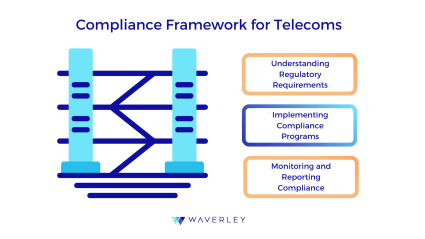
During OSS and BSS integration companies should pay special attention to matters of security. For example, vulnerabilities in software components, inadequate access controls, and insufficient data protection measures make it easier for hackers to perform malicious attacks.
Compliance and regulations in the telecom industry refer to the set of rules and guidelines that govern the operations and conduct of telecommunications companies. These rules are established by regulatory bodies to ensure fair competition, protect consumer rights, and maintain the integrity of the telecommunications infrastructure.
What are the possible risks of weak security measures in Telecom systems? We can name a few of the most prominent ones.
| Categories | Impact Details |
|---|---|
| Network Disruption | Interceptions disrupt the network’s performance and cause disturbances significant enough to bring down networks for several days, affecting critical services and generating significant revenue loss. |
| Data Leakage | Breaches can lead to the loss and violation of network or subscriber data as well as data traversing the network, also opening the possibility for systematic, long-term eavesdropping. |
| Business Impact | Companies affected by security breaches often experience a loss of customers and market share, as well as a long-term impact on brand value and stock price. Severe security breaches can also lead to legal action, with demands for compensation, as well as fines from regulatory bodies. |
Talking about compliance and regulations in the telecom industry, it is important to be aware of the key regulatory bodies that oversee and enforce these requirements. These regulatory bodies play a crucial role in ensuring that telecom companies adhere to the necessary standards and practices. Some of the prominent regulatory bodies in the telecom industry include the Federal Communications Commission (FCC), the International Telecommunication Union (ITU), and the National Telecommunications and Information Administration (NTIA).
With the proper telecom standards applied, we can be sure that our solutions will work globally, interacting with any other communication systems.
| Security Issues | Impact Descriptions |
|---|---|
| Vulnerabilities in Software Components | These vulnerabilities could be exploited by attackers to gain unauthorized access, execute arbitrary code, or compromise the integrity and confidentiality of data. |
| Insecure Authentication and Authorization Mechanisms | Weak authentication mechanisms, such as default credentials, weak passwords, or lack of multi-factor authentication, can make OSS and BSS systems vulnerable to brute-force attacks and credentials theft. |
| Lack of Security Patching and Updates | Failure to apply security patches and updates promptly can leave OSS and BSS systems vulnerable to known security vulnerabilities and exploits. |
| Denial of Service (DoS) Attacks | OSS and BSS systems may be targeted by denial of service (DoS) attacks aimed at disrupting services, exhausting system resources, or causing system downtime. |
How do you protect OSS / BSS data from data breaches?
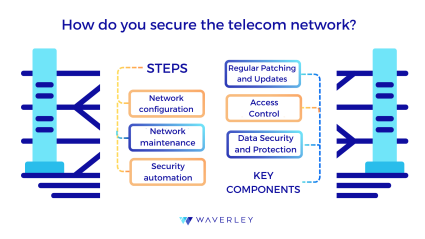
A comprehensive data security management and strategy process plays a vital role in an organization’s efforts to mitigate the risks associated with human errors and insider threats, both of which remain the primary causes of data breaches.
Why do OSS/BSS Require Ongoing Quality Assurance?
OSS and BSS help companies streamline daily activities, improve operational efficiency, and mitigate business risks. Through OSS, telecom providers oversee diverse operations with networks such as planning, configuration, service delivery, and fault management. BSS is responsible for the interaction between telecom companies and their end users. This stack includes billing, subscriptions, CRM, and more.
However, why do these systems require thorough screening? Let’s look into this in detail. There are several reasons:
- The activities performed within their work are related to the processing of sensitive and personal data of end users, and often such databases possess millions of records. When migrating to a new billing solution, for instance, these extensive quantities of data must be transferred in full and without affecting the routine actions of subscribers.
- When undergoing a digital transformation and following industry trends such as deploying edge computing for increased bandwidth and low latency or switching to 5G for accelerated connection speed, chances are high that their overall complexity will place a burden on telecom providers.
- Need-driven quality assurance makes the process of attaining business goals less complicated — 93% of service providers stated that it positively affects customer satisfaction and decreases the outflow of their subscriber base.
Therefore, QA and software testing eases the process of modernizing digital solutions, ensures boosted cybersecurity and performance, and allows for wise allocation of budgets as QA consulting and analysis help to define the pool of necessary verifications accurately.
Future Trends in OSS and BSS Development
The future of the OSS and BSS development market looks promising. With the increasing adoption of advanced technologies such as 5G, IoT applications, cloud solutions, and AI, telecom service providers are capable of implementing more flexible and agile OSS and BSS solutions than ever. The numbers from various surveys and industry research companies only confirm the future growth of the OSS and BSS market development.
Let’s take a look at the key future trends outlined in Next Generation OSS And BSS Market Report and MarkWide Research.
| Next-Generation OSS And BSS Market Report | MarkWide Research |
|---|---|
| Demand from the geographical area is estimated to boost growth. | 5G technology is becoming more common, and its speed increasing. Connection abilities through 5G enable more robust OSS/BSS solutions to help manage the complexity of the network and deliver high-quality services. |
| Inadequate Access Controls | Weak or misconfigured access controls in OSS and BSS systems can lead to unauthorized access to sensitive information and functionalities. This could result in data breaches. |
| Growing market segment adoption in the next-generation OSS and BSS industry. | OSS and BSS solutions can benefit the most from data analytics evolution. These systems are leveraging data analytics and AI to gain valuable insights into customer behavior or network performance. |
| Over the forecast period, higher growth rates are anticipated in some regions. | With the help of Cloud-native architecture, the adoption of cloud-native OSS and BSS solutions is growing fast. These solutions are attractive options for telecom operators because they offer ways to modernize the infrastructure. |
OSS and BSS Market Development by Regions
The demand for OSS and BSS development solutions is growing, and taking a look at the development of the market in different regions will give necessary insight into future trends.
| Region | Future Trends |
|---|---|
| North America | The North American market is expected to prevail, driven by 5G adoption, tech-savvy customers, and competition in the telecom industry. |
| Europe | Europe is having substantial growth due to regulatory initiatives, for example, the European Electronic Communications Code. This code was created to promote investments in high-capacity networks. |
| Asia-Pacific | This region is emerging as a promising market, with countries like China and India at the forefront of 5G deployment and digital transformation. |
| Latin America and the Middle East | These regions are experiencing steady growth because the telecom operators recognize the need to modernize their infrastructure. |
** European Electronic Communications Code – The EECC sets an EU-level legal framework to coordinate national legislation on electronic communications networks and services.
The next generation of OSS and BSS solutions looks promising. As the market grows, innovation will remain a driving force. Companies will need to adapt to evolving technologies, for example, AI/ML, and blockchain to stay relevant in the market.
Let’s look at the key players in the market. These companies are investing in research and development to meet the needs of the telecom industry. These are the noticeable players in the market:
- Amdocs Limited
- Ericsson
- Nokia Corporation
- Huawei Technologies Co., Ltd
- IBM Corporation
- Oracle Corporation
The global Cloud OSS BSS Market size was worth around USD 21.48 Billion in 2022 and is predicted to grow to around USD 53.72 Billion by 2030 with a compound annual growth rate (CAGR) of roughly 12.03% between 2023 and 2030.
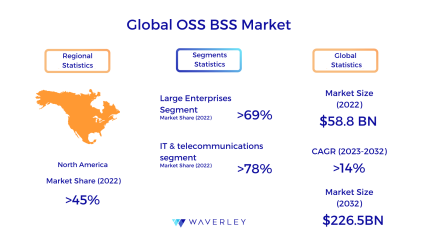
OSS/BSS solutions and services without a doubt help enterprises to improve their operational efficiency. The current business scenario is witnessing an upsurge in the usage of OSS across various verticals such as IT, telecom enterprises, BFSI, retail, media & entertainment, government, and manufacturing. The adoption of OSS/BSS solutions has increased significantly among communications service providers (CSPs) for activities such as taking a customer’s order, creating a bill, configuring network components, and managing faults. On the other hand, software-as-a-service (SaaS) has gained momentum with major software companies adopting cloud-based approaches to serve their customers better while reducing costs.
Waverley’s Experience
Waverley Software has a proven track record of successful cases in the telecom industry. Our development team boasts software developers experienced in building scalable and future-proof software products for companies across industries, providing digital transformation services, or delivering IoT development services.
Let’s look deeper into Waverley’s experience with OSS/BSS solutions. Waverley Software worked with Matrixx Software, a company that provides solutions for instant visibility, intelligence, and control of services for communications service providers. Our engineers delivered their mobile expertise to build mobile access to the client’s platform for communications service providers.
In mid-2015, Matrixx realized they needed expert help to build new mobile-based access to their industry-leading platform. That’s why they reached out to Waverley for our experience in building software products, and in native development on both iOS and Android, as well as the ability to turn a vision into user experience and the final design of new mobile software. Just like the full platform, the mobile version of MATRIXX would allow users to interact and configure their data experience in real-time while simultaneously handling the surging transaction volumes associated with LTE monetization.
This is just one of the case studies. Our list of customers from the Telecom Industry includes Swisscom, Vodafone, Qualcomm, J2Cloud, and others. For more detailed information please see our Telecom Software Development Page or reach out to our Sales team using the form at the bottom of this article.
Conclusion
To sum up, the flexibility of OSS and BSS systems makes them valuable in a wide variety of industries, where they help improve operational efficiency and customer satisfaction. In an increasingly interconnected world, OSS and BSS play a critical role in delivering high-quality services, optimizing resources, and improving the customer experience. Choosing the right solutions, and partners to build a software product, to deliver the solutions is the key to success.
Transform Your Business with OSS/BSS Development Services
FAQ
How do OSS and BSS systems interact with each other?
Operational support systems development and business support systems development interact very closely with each other to ensure the efficient delivery of telecommunications services. OSS is responsible for activating and configuring that service on the network, while BSS handles order management and billing.
What are OSS and BSS systems, and what roles do they play in the telecom and IT industries?
Both OSS and BSS solutions allow telecommunication companies and other communication service providers (CSPs) to create, organize, provision, maintain, and manage network services and orders. An operational support system is the backend information technology infrastructure.
What is the difference between OSS and BSS?
Even though OSS and BSS work efficiently together, however, BSS manages operations such as taking orders, payment problems, and processing invoices. The OSS includes information about the networks that are available, about their performance, allows members to manage networks, etc.
What programming languages and tools are commonly used in OSS and BSS development?
In OSS and BSS development several different languages and tools are commonly used, such as Java (backend systems, middleware, and web application), Python (data processing, scripting, automation), SQL (data operations), JavaScript (frontend interfaces, web applications in OSS, BSS systems), PHP (backend) etc.
What is the architecture of OSS and BSS?
OSS architecture mainly focuses on network administration. BSS architecture handles business tasks such as billing and customer management. Both of these systems significantly impact network operations and business management in telecom software development.
Optimize Operations with Expert OSS/BSS Development



